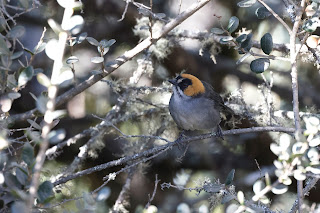We made the decision the previous day to spend the full day on the Pariahuanca Road, a long road passing through altiplano and upland scrub and Polyepis woodland, which is home to a few interesting species. This would then see us return to our original lodging in the town of Conception, come the evening. The plan seemed simple enough, get all the endemic birds about 65 kilometers down the road, before returning to the Altiplano in the afternoon to hopefully pick up a few bonus species.
But best-laid plans and all that. As it happened, there had
been a landslide 14 kilometres from our destination, but we did not know until
we arrived at the scene to find workmen clearing the road, and informing us
that it would not open again until midday. This meant that we had no choice but
to make the most of the situation and bird the area around the closure.
Fortunately, there was some good woodland, and as the morning warmed up were
rewarded with a number of good and interesting species.
Initially, we focused on the road, where we found our first
endemic to the region with Black-spectacled Brushfinch, with a pair showing
nicely. But frustratingly it was the only endemic we were able to find here. A
nest of Red-crested Cotinga with a chick was a surprise, and the flocks on the road
yielded a Moustached Flowerpiercer for me.
It wasn’t until we explored the area above the road that we
really began to hit our stride. First I managed brief views of Violet-throated
Starfrontlet, among the many Fire-throated Metaltails, both of which were
new for me and both uncommon throughout their range. But things really hit
their stride when we first encountered a Jalca Tapaculo showing well, followed
by a Stripe-headed Antpitta. The Tapaculo responded well to playback, even
sitting out in the open among the rocks, and it was while we were watching that
the Antpitta appeared in the same area. The antpitta then proceeded to climb a
tree to sing, and continued to show exceptionally well for the rest of the time
we watched it.
At midday the road opened and we were finally able to reach
our destination. The warm afternoon meant birding was slow, but we did manage
frustrating views of the as-yet undescribed ‘Mantaro Thornbird’, the only other
species present being Sierran Elaenia. We then had a little more success trying
for the as-yet undescribed ‘Mantaro Wren’ which actually showed well and gave us
nice views and vocal performance. A Yungas Pygmy Owl rounded off the afternoon.
It was already late afternoon when we left this site, leaving
us with a three-hour drive back to our lodging. This meant that we had to miss
out our planned exploration of the Altiplano. We had managed about twenty
minutes exploring in the morning, but the sun had barely risen and the thick
frost meant activity was low. Still, we had nice views of Glacier Finch and
Olivaceous Thornbill, against a stunning Andean backdrop. Just a shame we could
not explore more in the afternoon, as we had originally planned.
Pariahuanca Road: Ornate Tinamou, Andean Goose, Torrent Duck, Feral Pigeon, Band-tailed Pigeon, Sparkling Violetear, Olivaceous Thornbill, Fiery-throated Metaltail, Shining Sunbeam, Violet-throated Starfrontlet, Andean Lapwing, Puna Ibis, Yungas Pygmy Owl, Andean Flicker, Stripe-headed Antpitta, Jalca Tapaculo, Cream-winged Cinclodes, Mantaro Thornbird (undescribed form), Streak-throated Canastero, Creamy-crested Spinetail, Red-crested Cotinga, White-throated Tyrannulet, Tufted Tit-Tyrant, Sierran Elaenia, Rufous-breasted Chat-Tyrant, Brown-backed Chat-Tyrant, House Wren, Mountain Wren, Mantaro Wren (undescribed form), Great Thrush, Black-spectacled Brushfinch, Scarlet-bellied Mountain Tanager, Blue-and-black Tanager, Cinereous Conebill, Moustached Flowerpiercer, Black-throated Flowerpiercer, Masked Flowerpiercer, Glacier Finch, Plumbeous Sierra Finch,














No comments:
Post a Comment